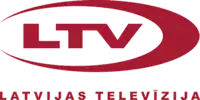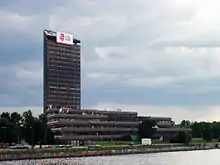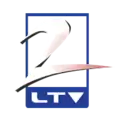Latvijas Televīzija
Latvijas Televīzija (English: Latvian Television, LTV) is the state-owned public service television broadcaster in Latvia. LTV operates two channels, LTV1 in Latvian and LTV7 (previously called LTV2) in Latvian with selected programming in Russian.
 | |
| Type | Broadcaster (TV, radio, online) |
|---|---|
| Country | |
| Availability | Latvia, online |
| Slogan | Skaties tālāk (Look Further) |
| Headquarters | Riga |
| Owner | Government of Latvia |
Key people | Ivars Priede (Board Member) |
Launch date | 6 November 1954 |
Channels | LTV1, LTV7 Formerly LTV2 |
| Affiliation(s) | European Broadcasting Union Public Broadcasting of Latvia |
Official website | ltv |
The broadcaster has been fully funded by the state budget since 1 January 2021, when, after years of debate, it and radio broadcaster Latvijas Radio exited the advertising market.[1] It is currently led by Ivars Priede, the sole Board Member (previously - by the Chairman of the Board).[2]
LTV is a member of the European Broadcasting Union, having joined on 1 January 1993. From the restoration of independence in 1991 to 31 December 1992, it was a member of the International Radio and Television Organisation (OIRT). LTV hosted the annual Eurovision Song Contest in 2003, as well as the IIHF Men's Ice Hockey Championships in 2006 and the inaugural Eurovision Choir of the Year competition in 2017.
LTV1 broadcasts the Eurovision Song Contest in Latvia each year, and LTV7 also broadcasts many sport events such as the Olympics, various Latvian league and national team games, Minor Hockey League, UEFA European Football Championship games and the FIFA World Cup.
History
1954 to 1993
First test broadcasting started on 6 November 1954 from Soviet Riga in black-and-white and it was seen by only 20 television owners. It is the first and oldest national television station in the Baltic countries. Regular broadcasting started on 20 November 1954. At the start, LTV didn't have rights to create their own programming. In 1955 Riga's Television studio was created and since then programming was created by the studio.
On 19 March 1958, the first evening news show went on the air. In 1963, it was renamed to Panorāma, as it is known to this day. A second TV channel was launched in 1961 and both channels converted to SÉCAM color in 1974. In 1986, both the Riga TV Tower and the LTV television headquarters were officially completed.
1993 onwards

On 1 January 1993, Latvian Television and Radio Latvia became members of the European Broadcasting Union (EBU). On 2 February 1998, LTV along with LNT, Channel 31 (now TV3) and TV Riga (later TV5) converted to PAL color. In 2006, LTV2, the second channel, was rebranded as LTV7.
In 2008, LTV started broadcasting in digital terrestrial TV standard in MPEG2 format, changing to MPEG4 format on 1 August 2009 as the telecommunications company Lattelecom has been chosen to be the official integrator of digital terrestrial TV in Latvia. Analogue distribution of LTV7 finished on 1 March 2010. LTV completely finished broadcasting LTV1 in analogue format on 1 July 2010. Both LTV channels are also available on the Sirius satellite's Nordic beam as part of the Viasat package.
LTV changed its aspect ratio from 4:3 to 16:9 in 2003.[3] A full switch to HDTV broadcasts, currently planned for 2021 or 2022,[4] has not so far been implemented due to financial constraints,[5][6] although selected programming such as live broadcast of a staging of The Nutcracker by the Latvian National Opera on LTV1 in 2012[7] and the matches of the IIHF World Championships on LTV7 since 2018, has been shown in HD.[8]
Until 2021, the broadcaster was funded by grant-in-aid from the Latvian government (around 60%), with the remainder coming from television commercials. Although moving LTV to licence fee funding was long been debated, this was often opposed by the government, with media analysts believing that the real reason for this is that the government is reluctant to lose the control of LTV that state-funding gives it.
Public Broadcasting of Latvia (since 2013)
Since 2013 LTV has come under the umbrella of Public Broadcasting of Latvia along with Radio Latvia, as part of the unification process of both public broadcasters. LTV and Radio Latvia now share one news portal, LSM.lv, and an online streaming service (REplay.lv), with content from both broadcasters.
In 2017 LTV launched the online channel Visiem LTV (also styled VISIEMLTV.LV) for foreign viewers, mostly targeted for the Latvian diaspora. The programming is a mix of LTV1 and LTV7 broadcasts that are not restricted by copyright laws and are available globally.[9]
After years of debate, in June 2018 the Saeima unanimously voted to amend legislation allowing the public broadcaster to exit the advertising market and be fully funded by the state budget.[10] In 2020 the necessary funding was earmarked by the Government of Latvia, with Latvijas Televīzija and Latvijas Radio exiting the ad market effective January 1, 2021.[1]
Logos
 Latvijas Televīzija (LTV1) logo (2017–)
Latvijas Televīzija (LTV1) logo (2017–) Latvijas Televīzija (LTV7) logo (2012–present)
Latvijas Televīzija (LTV7) logo (2012–present) LTV1 logo (2013–2017)
LTV1 logo (2013–2017) LTV1 logo (2006–2013)
LTV1 logo (2006–2013) LTV7 logo (2006–2012)
LTV7 logo (2006–2012) Latvijas Televīzija (LTV1) logo (2003–2006); LTV7 used a similar logo with a red number 7 instead of 1 at the same time.
Latvijas Televīzija (LTV1) logo (2003–2006); LTV7 used a similar logo with a red number 7 instead of 1 at the same time. LTV2 logo (2000–2002). LTV1 used a similar logo with a skewed "1" in the square.
LTV2 logo (2000–2002). LTV1 used a similar logo with a skewed "1" in the square. Visiem LTV logo
Visiem LTV logo
See also
- Eastern Bloc information dissemination
- List of Latvian television channels
References
- "Public media exits the advertising market". Public Broadcasting of Latvia. 2 January 2021. Retrieved 21 January 2021.
- "Kontakti un rekvizīti / LTV.LV". ltv.lsm.lv. Retrieved 21 January 2021.
- https://www.youtube.com/watch?v=Ctw_jFyYrnk LTV1 maina attēla malu attiecību uz 16:9. ltvpanorama on YouTube.
- "Salipinātā sistēma, dārgā lībiešu sēta un sniega pika vēlās ilgi… "LA" nedēļas apskats". LA.lv (in Latvian). 7 January 2019. Retrieved 20 January 2019.
- "LTV pārejai uz augstas izšķirtspējas apraidi nepieciešami aptuveni astoņi miljoni eiro (Switching to high-definition broadcasts for LTV requires approx. 8 million Euro)". Diena (in Latvian). 2 August 2017. Retrieved 20 January 2019.
- "Apstiprina LTV un LR 2017. gada pārskatus". neplpadome.lv (in Latvian). 2 August 2017. Retrieved 20 January 2019.
- "Baleta «Riekstkodis» translācija – pirmā LTV tiešraide augstas izšķirtspējas kvalitātē (First-ever LTV live broadcast in HD – ballet "The Nutcracker")". LSM.lv (in Latvian). 17 December 2012. Retrieved 20 January 2019.
- "Lattelecom and Latvian Television gain exclusive six-year broadcast rights in Latvia to the IIIHF Ice Hockey World Championship | lattelecom.lv". www.lattelecom.lv. 16 May 2017. Retrieved 20 January 2019.
- "VISIEMLTV.LV – jauns interneta televīzijas kanāls latviešiem ārzemēs".
- "No ads on public media starting 2021, parliament says". eng.lsm.lv. 20 June 2018. Retrieved 21 January 2021.